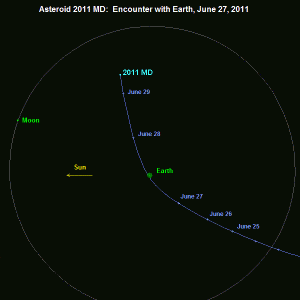Earlier this week, we had a close shave. An asteroid passed by the Earth at just 12,000 km. The distance between the Earth and the Moon is roughly 400,000 km. That was really, really close!
The asteroid was between 5 and 20 km in diameter and probably would have burned up and exploded upon entering the Earth’s atmosphere. But that’s not what I find most interesting about this. What is interesting is how little notice we had of its passing. Astronomers found the rock on Monday, before its passing on Wednesday. We have many, many telescopes aimed into space to give us warning of rocks just like these. But sometimes they just don’t see them – it really is like trying to find needles in haystacks. Although it is probably more like trying to find a speck of dust on a farm.
Below is an image from NASA’s Near Earth Object program shows just how close the asteroid came. Especially when you consider the size of the universe. I’m still struggling to get my head around just how close it was.

June 30 was World Meteor Day. Maybe the asteroid just wanted to join in the party.
Hopefully, his much bigger friends don’t try to gate crash anytime soon.
Holly,
























This page is unreadable
Hi Sarah,
Thanks for the heads up! Not sure if the text was not coming up for you or if whether it was the tense issue in the prose? Holly’s blog on the asteroid near-miss was a bit shorter than our usual articles. You can check out more information on this topic via the NASA JPL’s Center for Near Earth Object Studies. Also, 2019’s National Science Week theme is Destination Moon and this link has a bunch of lunar teaching ideas that you can use in your classroom.
All the best,
Ben